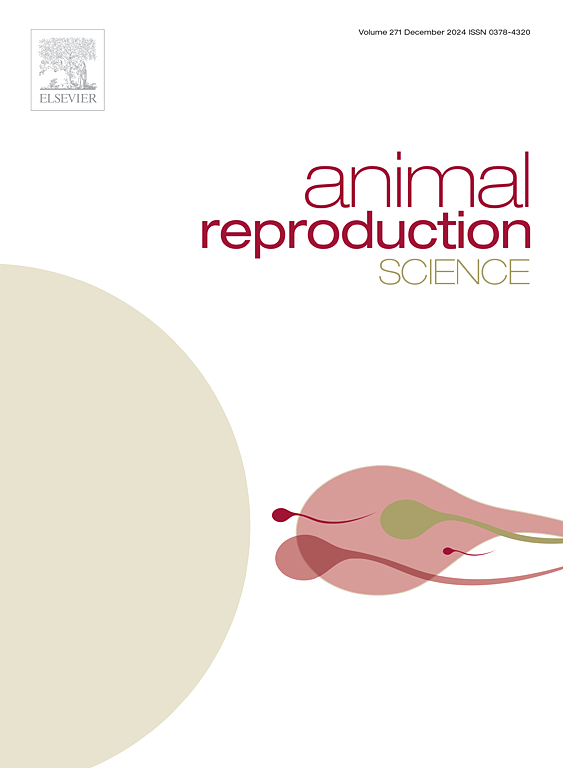AMPKα可减轻NEFA对体外培养的牛滤泡颗粒细胞功能的抑制作用
IF 2.2
2区 农林科学
Q1 AGRICULTURE, DAIRY & ANIMAL SCIENCE
引用次数: 0
摘要
患有亚临床酮症(SCK)的奶牛体内高水平的非酯化脂肪酸(NEFA)会损害产后卵泡发育并扰乱发情。NEFA影响牛滤泡细胞功能的确切机制尚不清楚。对未发情的SCK奶牛(SCK- e, n = 6)与处于发情状态的健康奶牛(C-E, n = 6)进行了体内试验比较。在体外试验中,牛颗粒细胞(GCs)暴露于0.4 mM NEFA中。值得注意的是,与C-E组相比,SCK-E组肝脏和卵巢组织中磷酸化腺苷5′-单磷酸活化蛋白激酶α (AMPKα)与总AMPKα的比例均升高。NEFA处理GCs对类固醇激素合成产生不利影响,抑制细胞周期蛋白和类固醇合成关键蛋白的表达,引发细胞凋亡,从而抑制细胞增殖。此外,它导致细胞线粒体膜电位下降,活性氧产生增加,最终导致细胞损伤。随后,将GCs与腺病毒(ad-AMPKα-siRNA)和NEFA(0.4 mM)共培养。抑制AMPKα进一步加剧了NEFA对GCs中类固醇激素合成、细胞凋亡、细胞增殖和线粒体功能的不利影响。此外,抑制AMPKα后,乙酰辅酶a羧化酶1的mRNA和蛋白水平均降低,同时肉毒碱棕榈酰基转移酶1的水平升高。这些发现表明,在NEFA水平升高的SCK奶牛中,AMPKα被激活,并且AMPKα有可能减轻NEFA对体外GCs功能的有害影响。本文章由计算机程序翻译,如有差异,请以英文原文为准。
AMPKα alleviates the inhibitory effect of NEFA on the function of bovine follicular granulosa cells cultured in vitro
High levels of non-esterified fatty acids (NEFA) in cows with subclinical ketosis (SCK) impair postpartum follicular development and disrupt estrus. The precise mechanism through which NEFA impacts the functionality of bovine follicular cells remains elusive. An in vivo experiment was conducted to compare SCK cows without estrus (SCK-E, n = 6) with healthy cows in estrus (C-E, n = 6). In the vitro test, bovine granulosa cells (GCs) were exposed to 0.4 mM NEFA. Notably, the SCK-E group exhibited an elevated ratio of phosphorylated adenosine 5’-monophosphate-activated protein kinase α (AMPKα) to total AMPKα in both liver and ovarian tissues, compared to the C-E group. NEFA treatment of GCs adversely affected steroid hormone synthesis, suppressed the expression of cyclin and proteins crucial for steroid synthesis, and triggered cell apoptosis, thereby inhibiting cell proliferation. Furthermore, it led to a decline in cell mitochondrial membrane potential and an increase in reactive oxygen species production, ultimately causing cellular damage. Subsequently, GCs were co-cultured with adenovirus (ad-AMPKα-siRNA) and NEFA (0.4 mM). Inhibiting AMPKα further exacerbated the detrimental effects of NEFA on steroid hormone synthesis, cell apoptosis, cell proliferation, and mitochondrial function in GCs. Furthermore, upon inhibiting AMPKα, a reduction was observed in both mRNA and protein levels of acetyl-CoA carboxylase 1, accompanied by an elevation in the levels of carnitine palmitoyltransferase-1. These findings suggest that AMPKα becomes activated in SCK cows experiencing elevated NEFA levels, and that AMPKα has the potential to mitigate the detrimental effects of NEFA on GCs function in vitro.
求助全文
通过发布文献求助,成功后即可免费获取论文全文。
去求助
来源期刊

Animal Reproduction Science
农林科学-奶制品与动物科学
CiteScore
4.50
自引率
9.10%
发文量
136
审稿时长
54 days
期刊介绍:
Animal Reproduction Science publishes results from studies relating to reproduction and fertility in animals. This includes both fundamental research and applied studies, including management practices that increase our understanding of the biology and manipulation of reproduction. Manuscripts should go into depth in the mechanisms involved in the research reported, rather than a give a mere description of findings. The focus is on animals that are useful to humans including food- and fibre-producing; companion/recreational; captive; and endangered species including zoo animals, but excluding laboratory animals unless the results of the study provide new information that impacts the basic understanding of the biology or manipulation of reproduction.
The journal''s scope includes the study of reproductive physiology and endocrinology, reproductive cycles, natural and artificial control of reproduction, preservation and use of gametes and embryos, pregnancy and parturition, infertility and sterility, diagnostic and therapeutic techniques.
The Editorial Board of Animal Reproduction Science has decided not to publish papers in which there is an exclusive examination of the in vitro development of oocytes and embryos; however, there will be consideration of papers that include in vitro studies where the source of the oocytes and/or development of the embryos beyond the blastocyst stage is part of the experimental design.
 求助内容:
求助内容: 应助结果提醒方式:
应助结果提醒方式:


